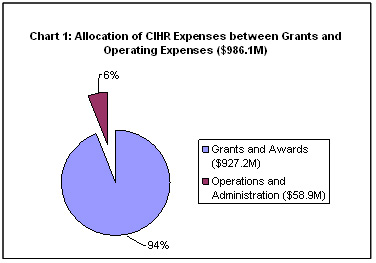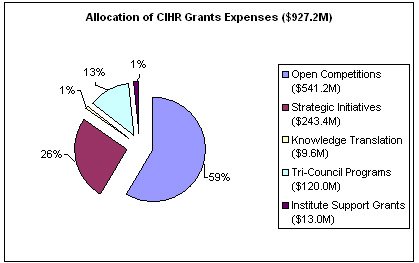Common menu bar links
Breadcrumb Trail
ARCHIVED - Canadian Institutes of Health Research
 This page has been archived.
This page has been archived.
Archived Content
Information identified as archived on the Web is for reference, research or recordkeeping purposes. It has not been altered or updated after the date of archiving. Web pages that are archived on the Web are not subject to the Government of Canada Web Standards. As per the Communications Policy of the Government of Canada, you can request alternate formats on the "Contact Us" page.
Section III: Supplementary Information
Financial Highlights
| Condensed Statement of Financial Position At End of Year (March 31, 2009) |
% Change | 2009 | 2008 |
|---|---|---|---|
| Assets | |||
| Financial Assets | (56.5%) | 16,236 | 37,328 |
| Non-Financial Assets | 21.4% | 3,903 | 3,216 |
| Total Assets | (50.3%) | 20,139 | 40,544 |
| Liabilities | (45.0%) | 24,327 | 44,259 |
| Equity | 12.7% | (4,188) | (3,715) |
| Total Liabilities & Equity | (50.3%) | 20,139 | 40,544 |
| Condensed Statement of Operations At March 31, 2009 |
% Change | 2009 | 2008 |
|---|---|---|---|
| Grants and awards expenses | (3.0%) | 927,238 | 956,101 |
| Refund of previous years’ grants and awards | (6.0%) | (2,901) | (3,087) |
| Operations and administration expenses | 6.4% | 58,868 | 55,328 |
| Total Expenses | (2.5%) | 983,205 | 1,008,342 |
| Total Revenues | 10.4% | 10,365 | 9,385 |
| Net Cost of Operations | (2.6%) | 972,840 | 998,957 |
Condensed Statement of Financial Position:
Total Assets and Total Liabilities both decreased by approximately $20M compared to 2007-08. These decreases resulted largely from the accrual of a $20M conditional grant (in the form of an endowment) that was to be paid to the Gairdner Foundation as at March 31, 2008. The Gairdner Foundation grant was subsequently disbursed in June of 2008, which explains the decrease in Total Assets and Total Liabilities of CIHR at March 31, 2009.
Condensed Statement of Operations:
Grants and awards expenses decreased by $28.9M (or 3.0%) in 2008-09 compared to 2007-08. The primary reason for this decrease is due to the fact that in 2007-08, CIHR recorded a one-time $20M expense pertaining to a conditional grant (in the form of an endowment) awarded to the Gairdner Foundation in March of 2008. This $20M grant was expensed in CIHR's 2007-08 Statement of Operations. No such expense was incurred by CIHR in 2008-09. In addition, CIHR's total authorities declined by $19.7M (or 2.0%) as compared to 2007-08, due primarily to a decrease to appropriations for the Centres of Excellence for Commercialization and Research Program. The combination of lesser authorities for CIHR as well as the one-time expense incurred in 2007-08 for the Gairdner Foundation grant resulted in a $28.9M decrease in grants and awards expenses in 2008-09.
The Operations and Administration expenses increased by $3.6M in 2008-09 due to higher employee wages and higher contributions to employee benefit plans. Revenues for 2008-09 remained fairly constant with revenues earned in 2007-08.
Financial Highlights Chart
As Chart 1 illustrates, CIHR allocates 94% of its available budget directly to health researchers across Canada to fund health research and knowledge creation, train the next generation of health researchers, build research capacity in under-developed areas and to focus on knowledge translation, so that the results of research are transformed into improved policies, practices, products and services which results in improved health for all Canadians. The remainder of its funding is used to finance CIHR's operations.

CIHR incurred the majority (59%) of its grants and awards expenses to fund Open competitions. CIHR recognizes that the creativity, skill, and insight of individuals and self-assembled teams lie at the heart of the research enterprise. The pursuit of excellence in research, as evaluated through the peer review process, inspires ideas that drive progress and ensures a continuous flow of fresh insights. As such, open competition programs enable individual researchers or groups of investigators to identify research opportunities in any area of health research that they consider to be of importance or with unique opportunity.

Strategic initiatives comprise the second largest portion of CIHR grants and awards investments (26%). These investments target high priority research areas identified by CIHR's Institutes after broad consultations with stakeholders and partners. These strategic initiatives address emerging health threats and other important health issues of concern to Canadians including areas of health research such as obesity, cancer, vulnerable populations such as youth and aboriginals, pandemic preparedness, HIV/AIDS, or measures to improve the effectiveness of the Canadian health care system.
Knowledge Translation (KT) is a critical and growing part of CIHR's mandate focused on the synthesis, exchange and ethically-sound application of knowledge to accelerate the capture of the benefits of research for Canadians through improved health, more effective services and products and a strengthened health care system. In 2008-09, grants and awards expenses related directly to Knowledge Translation increased by 16.8%.
CIHR incurred 13% of its 2008-09 grants and awards expenses on tri-council programs – key Government of Canada flagship programs which are jointly administered by CIHR, Natural Sciences and Engineering Research Council (NSERC) and Social Sciences and Humanities Research Council (SSHRC). CIHR incurred expenses totalling $87.7M on the Canada Research Chairs (CRC) Program. The CRC Program awards key research professorships at post-secondary institutions across Canada to attract and retain some of the world's most accomplished and promising minds. CIHR also spent $27.9M on the Networks of Centres of Excellence (NCE) Program, which brings together partners from the academic, industry, public and non-public centres to conduct leading edge research and knowledge translation activities in areas of strategic growth and opportunity for Canada. CIHR incurred further expenses totalling $4.4M on the Centres of Excellence for Research and Commercialization (CECR) Program. The CECR Program supports the operation of commercialization and/or research centres that bring together people, services, and infrastructure to maximize the benefits of the government's investments in skills and research and to encourage greater private sector investment in science and technology.
CIHR has 13 "virtual" institutes that represent the full spectrum of health science research. Each institute brings together research funders, researchers and research users, including policy-makers and practitioners, to set strategic priorities for research. Each host institution which houses a CIHR institute administers a $1M Institute Support Grant to be used to meet the expenses of housing and running the institutes.
Financial Statements
Follow this link to view CIHR's 2008-09 Audited Financial Statements.
List of Supplementary Information Tables
Table 1: Sources of Respendable and Non-Respendable Revenue
Table 5: Details on Transfer Payment Programs
Table 6: Up-Front Multi-Year Funding
Table 10: Response to Parliamentary Committees and External Audits
Table 11: Internal Audits & Evaluations
